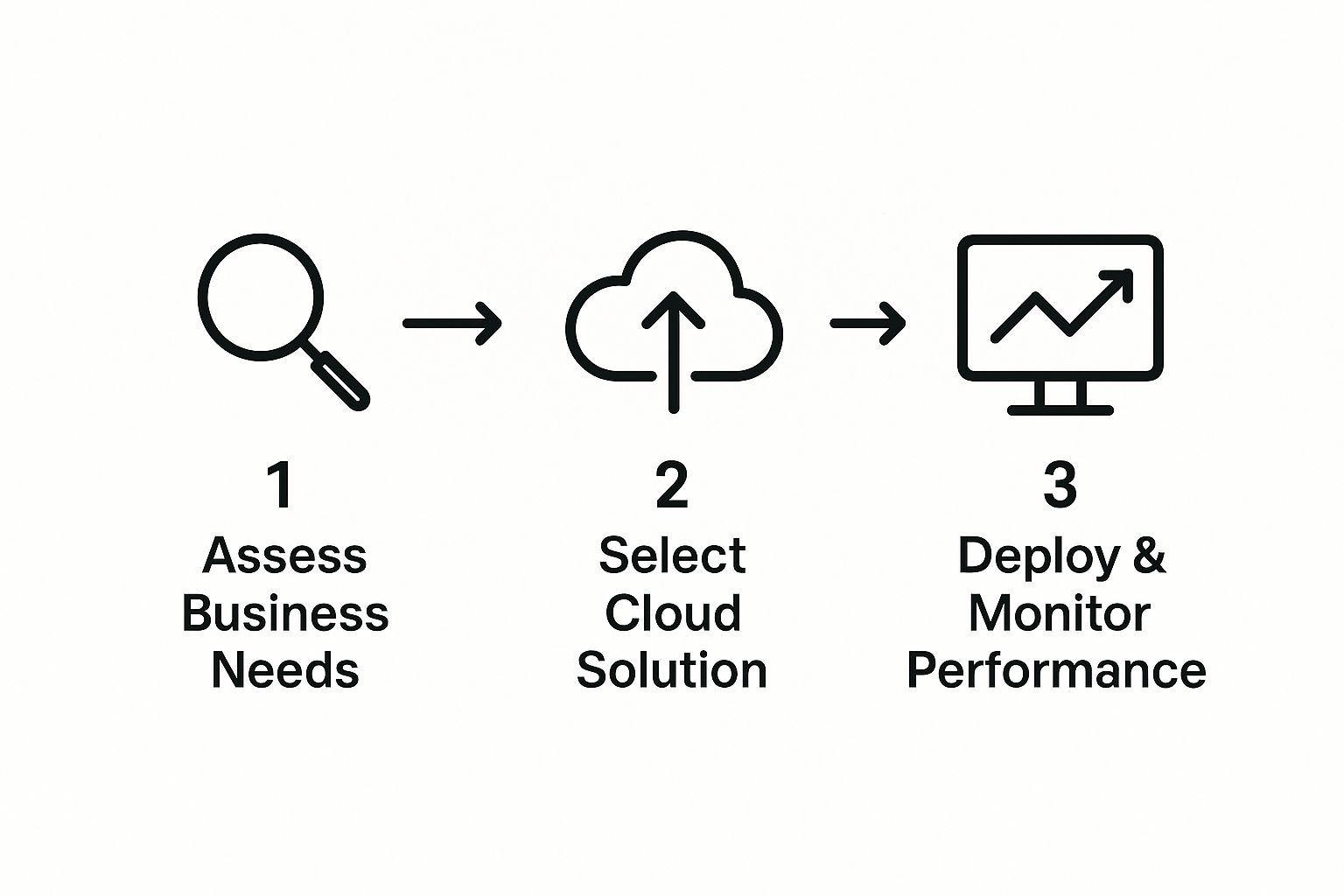Digital Transformation for Small Business: Boost Growth Today
When you hear the term "digital transformation," it's easy to picture massive corporations overhauling their entire IT infrastructure. But for a small business, it's something much more practical. It's simply the process of using modern technology to improve how you operate and serve customers.
Forget complex tech projects. This is about making smart upgrades that boost your efficiency, create better experiences for your customers, and open up new ways to grow.
What Is Digital Transformation Really for a Small Business?

Let's ditch the corporate jargon for a minute. Think of digital transformation like renovating your favorite local shop to meet the needs of today's customers. You’re not just slapping on a new coat of paint. You’re upgrading the wiring, rethinking the store layout, and installing a modern payment system to make everything smoother.
This isn’t about chasing every shiny new gadget that comes along. It's about strategically picking the right tools to solve your real-world problems. For a great deep dive into the core concept, check out this guide on What is Digital Transformation?. The real goal is to make your business more resilient, efficient, and completely focused on your customers.
The Three Pillars of Transformation
The journey of digital transformation for small business really stands on three core pillars. Each one represents a fundamental area where technology can make a huge, positive impact. If you focus your efforts here, you'll see the biggest returns.
- Elevating the Customer Experience: This is all about using tech to make every interaction with your business feel seamless and personal. Think of a salon adding an online booking system or a local boutique launching a simple e-commerce store. It's about meeting customers where they are.
- Optimizing Daily Operations: This pillar is about working smarter, not harder. It means automating repetitive tasks like sending invoices, using software to manage inventory, or adopting project management tools to keep your team on the same page.
- Unlocking New Business Models: This is where things get really exciting. It's about finding new ways to generate revenue. A personal trainer could start offering online coaching sessions, or a restaurant could launch a subscription meal-kit service. Technology opens up doors that were previously closed.
Digital transformation isn’t a one-and-done project. It's a continuous mindset of using technology to improve your business, one step at a time. It’s about progress, not perfection.
This shift isn't just a "nice to have" anymore—it's becoming essential for survival and growth. By 2025, a massive 70% of small and medium-sized businesses are expected to significantly change how they work by adopting digital tools across their operations. This wave is being driven by technologies like cloud computing and AI, and jumping on board is critical for staying competitive. By focusing on these three core areas, you can build a stronger, more future-proof business.
The Tangible Benefits of Going Digital

Talking about "digital transformation" is great, but what does it actually do for you? For a small business, this isn't about chasing buzzwords. It's about real, concrete wins that save you time, make customers happier, and grow your bottom line.
These are the practical advantages that make the effort worthwhile. Let's dig into four game-changing benefits a smart digital approach can bring, each with a simple, relatable example.
1. Boosted Efficiency and Productivity
One of the first things you'll notice is how much time you get back. Digital tools are incredible at automating the tedious, repetitive tasks that drain your day. Think about all the hours spent manually sending invoices, booking appointments, or chasing down payments.
For example, a freelance graphic designer who used to spend hours every month creating and emailing PDF invoices can switch to a cloud accounting tool. Suddenly, invoices go out automatically, reminders are sent without them lifting a finger, and clients can pay online in seconds. This single change can easily free up 5-10 hours a month—time better spent on creative work or landing new projects.
This is exactly what basic marketing automation does, too. You can check out our complete guide to marketing automation for small business to see more ways to get your valuable time back.
2. A Superior Customer Experience
Today’s customers expect things to be easy. A smart digital strategy puts their needs first, creating the kind of smooth, simple interactions that build loyalty and keep people coming back. This could be as simple as an online booking system for a local barber or a CRM that remembers a customer's past orders.
Take a small coffee shop that adds a mobile ordering app. Customers can now order ahead, pay with their phone, and skip the line entirely. This doesn't just make things faster; it also collects data on what's popular, letting the shop send personalized deals to its regulars.
The core of a great customer experience is making it easy for people to do business with you. Digital tools remove friction, turning a simple transaction into a lasting relationship.
Tools like chatbots are another great way to improve customer interactions. You can explore the typical benefits of chatbots for a business to see how they offer 24/7 support and instantly answer common questions.
3. Smarter Decision Making
Running a business on guesswork is a recipe for disaster. Digital tools give you clear, simple data so you can make confident choices instead of just hoping for the best. You no longer have to guess which product is your bestseller or which marketing channel is actually bringing in customers.
Imagine a local bakery using the analytics from its point-of-sale (POS) system. By looking at the numbers, the owner discovers that their gluten-free pastries sell out by 10 AM every Friday. With that insight, they can tweak the baking schedule to meet demand, cut down on waste, and boost profits.
That’s the power of data-backed decision-making in action. It’s simple, effective, and takes the guesswork out of growth.
4. Expanded Market Reach
Finally, digital tools tear down geographical walls, letting even the smallest local business reach a massive audience. A simple e-commerce website or a savvy social media presence can connect you with customers far beyond your own neighborhood.
Think about an artisan who makes handcrafted leather goods in a small town. By setting up an online store and running a few targeted social media ads, they can suddenly sell to people across the country—or even around the world. This opens up entirely new revenue streams that were impossible with just a brick-and-mortar shop, turning a local favorite into a global brand.
Your Step-by-Step Digital Transformation Roadmap
Jumping into a digital transformation can feel like planning a huge road trip without a map. You know where you want to go—a more efficient, profitable, and customer-friendly business—but the route looks overwhelming.
Don't worry. This roadmap breaks the journey into clear, manageable steps. This isn't about flipping a switch and changing everything overnight. It's about taking one thoughtful step at a time, building momentum as you go, and creating a plan that actually fits your business.
Step 1: Take Stock of Where You Are Right Now
Before you can get where you're going, you need to know exactly where you're starting. This first step is all about a brutally honest look at your current business operations. You need to pinpoint the real pain points holding you back.
Get your team together and ask some tough questions:
- What are the most soul-crushing manual tasks we do every single week?
- Where are our customers getting stuck or frustrated when they deal with us?
- Which parts of our day-to-day work feel clunky, ancient, or just plain slow?
- Are messages getting lost between people or departments?
The goal is to find the specific problems that need fixing. Maybe it’s a chaotic appointment system that still runs on phone calls and sticky notes. Perhaps it's the hours you waste every month trying to pull together sales reports by hand. Nailing these down is the foundation of your entire plan.
Step 2: Set Crystal-Clear Goals
Okay, you've identified the problems. Now, what does "fixed" actually look like? Vague goals like "get more efficient" are useless here. You need sharp, specific, and measurable targets.
For example, instead of saying "sell more online," a much better goal is to "increase online sales by 20% within the next six months." Now you have a clear target to aim for and a way to know if you've hit it.
A well-defined goal is your North Star for this whole process. It keeps you on track and makes sure every decision, every tool, and every change is pulling you in the right direction.
A few other examples of strong, clear goals:
- Cut the time we spend on admin and invoicing by 50% in the next three months.
- Boost our positive customer reviews online by 15% this quarter.
- Make sure we respond to every new lead within one hour of them contacting us.
Step 3: Prioritize for the Biggest Impact
You can't do everything at once, and you shouldn't even try. The secret to keeping things moving is to score some quick wins. These are the changes that deliver the most bang for your buck with the least amount of effort.
This is where a simple priority matrix comes in handy. It’s a great way to map out your digital projects so you can tackle the most important ones first.
Digital Transformation Priority Matrix for Small Businesses
This framework helps you decide what to do now, what to plan for later, and what to put on the back burner. Just plot your ideas based on their potential impact and how hard they'll be to pull off.
| Initiative Type | Example Action | Business Impact | Implementation Effort |
|---|---|---|---|
| Quick Wins | Set up a simple CRM to track customer interactions. | High | Low |
| Major Projects | Launch a full e-commerce website with inventory management. | High | High |
| Fill-Ins | Create an internal knowledge base for team procedures. | Low | Low |
| Reconsider Later | Develop a custom mobile app for a niche customer segment. | Low | High |
By focusing on the "High Impact, Low Effort" tasks first, you build momentum and show your team that these changes are making a real difference.
The investment in this area is exploding—global spending on digital transformation is expected to hit a staggering $3.9 trillion by 2027. For a small business, being smart and strategic about where you put your resources is the only way to compete.
The image below shows a simple flow for putting a new solution in place, from the initial assessment all the way to checking its performance.

This just reinforces the need for a structured plan. You need to know why you're choosing a tool and how you'll track its success.
Step 4: Choose the Right Tools for the Job
With your priorities straight, it's time to find the right tech. The market is absolutely flooded with software, so it's easy to get distracted by flashy features you'll never use.
Stay focused. Find tools that solve your specific problems. Look for software that’s easy to use, fits your budget, and can grow with you.
And please, use the free trials! Get your team to test-drive a few options in a real-world setting. Remember, the best tool in the world is useless if your team hates it and won't use it. For more ideas on improving your internal workflows, check out our guide on how to streamline business processes.
Step 5: Get Your Team On Board
Let's be clear: the tech is the easy part. Your people are what will make or break this entire effort. People naturally resist change, so you have to bring them along for the ride.
Explain the why. Show them how these new tools will make their jobs easier, not just add another thing to their to-do list. Provide great training and be patient while everyone gets up to speed. When your team sees the benefits for themselves, they’ll become your biggest advocates.
Step 6: Measure What Matters
Finally, you have to track your progress. Go back to those goals you set in Step 2. Are you actually hitting that 20% increase in sales? Did you really cut invoicing time by 50%?
The data will tell you what's working and what's not. This isn't a one-and-done project; it’s a constant cycle of doing, measuring, and adjusting. Keep an eye on your results, listen to feedback from your team and customers, and don't be afraid to tweak your plan as you learn. That's how real growth happens.
Essential Digital Tools That Drive Growth

Once you have a roadmap, it’s time to pick your vehicle. The world of business technology can feel like a crowded, noisy showroom, but you don't need a hundred different apps to make a real difference. The secret is to focus on the job each tool gets done, not just the flashy brand name.
Let’s cut through the noise and look at the core types of digital tools that give small businesses the best bang for their buck. Understanding what each one does will help you build your tech stack with confidence.
Cloud Accounting Software
The days of drowning in a shoebox full of receipts or wrestling with clunky spreadsheets are officially over. Think of cloud accounting software as your financial command center, built to make managing money straightforward and dead-on accurate.
It tackles the headache of manual bookkeeping, which is slow, full of potential errors, and makes it impossible to know where you stand financially in real time. This software automates invoicing, expense tracking, and even payroll, spitting out financial reports with just a few clicks. Best of all, since it’s in the cloud, you and your accountant can access it from anywhere, anytime.
Customer Relationship Management (CRM) Systems
Your customers are the heart of your business, but trying to remember every single conversation, email, and sale is a recipe for disaster. A Customer Relationship Management (CRM) system acts as your company’s shared brain.
A CRM neatly organizes every customer interaction into one central hub. It stores contact info, communication history, and sales activity, giving your whole team a complete picture of each relationship. This means you can deliver more personal service and follow up on leads without ever letting things slip through the cracks.
By the end of 2023, around 95% of small business owners were using at least one technology platform to manage their operations, with most averaging four different tools.
This isn't just a trend; it's the new standard. And what’s the biggest reason for going digital? Growth, cited by 55% of businesses. A solid CRM is often the first and most important step on that journey. If you want to dive deeper, you can find more small business statistics and see how companies are using tech to expand.
Project Management and Collaboration Platforms
When your team is juggling multiple projects, communication breakdowns are almost guaranteed—unless you have the right system in place. Project management and collaboration platforms are designed to keep everyone perfectly in sync, no matter where they’re working from.
These tools create a central space for assigning tasks, sharing files, setting deadlines, and watching progress unfold in real time. They kill messy email chains and create a single source of truth for every project. The result? Everyone knows exactly what they need to do and when, which slashes confusion and keeps the momentum going.
Digital Marketing and SEO Tools
Having an amazing product or service is only half the battle. If people can't find you online, you might as well be invisible. Digital marketing and SEO tools are your megaphone, helping you reach new customers and carve out your space online.
- Problem It Solves: Without a deliberate online strategy, your business gets lost in a sea of competitors.
- What It Does: This category covers everything from social media schedulers and email marketing platforms to keyword research tools that help you climb the ranks on Google.
- Key Features to Look For: Start with tools that have user-friendly analytics dashboards, simple content editors, and time-saving automation features.
For instance, a tool like LeadSavvy Pro directly solves a major marketing headache by automating how you get leads from Facebook ads. Instead of manually downloading CSV files, it zaps new leads straight into a Google Sheet or your CRM for instant follow-up. That simple automation is a perfect, real-world example of digital transformation in action.
E-commerce and Online Payment Solutions
Last but not least, you have to make it ridiculously easy for people to give you their money. E-commerce platforms and online payment solutions remove all the friction from the buying process, whether you're selling products or services.
These tools let you build an online storefront, manage your inventory, and securely accept payments through credit cards, digital wallets, and more. For service-based businesses, they can handle online bookings and deposits. The goal is to make the entire transaction so smooth that your customer doesn't even have to think about it.
Navigating Common Digital Transformation Hurdles
Taking your business digital is a huge step, but let's be real—it’s not always a smooth ride. Making big changes is tough, especially when you’re already juggling a dozen other things. The trick is to know what roadblocks are coming so you can plan for them instead of getting blindsided.
The good news? These hurdles are incredibly common, and countless businesses have cleared them. It’s all about having a smart strategy. We'll walk through the four biggest obstacles you'll likely face and give you practical ways to knock them down.
Dealing with Tight Budgets and Limited Resources
For almost every small business owner, the first question is always the same: "Okay, but how much is this going to cost me?" That fear of a massive, budget-breaking bill stops a lot of people before they even get started. But here’s the truth: a powerful digital transformation for small business doesn't require a Fortune 500 budget.
The secret is to start small. Focus on high-impact, low-cost moves first. You don't need a pricey, all-in-one software suite on day one.
- Hunt for High-ROI Projects: Look at your roadmap and find the "quick wins." An automation tool that saves you five hours a week gives you a much faster return than a total website overhaul.
- Embrace Free and Freemium Tools: So many great platforms offer free starter plans. You can set up a basic CRM, use free project management software, or kick off an email marketing list without spending a single dollar.
- Think Incrementally: Roll out one new tool at a time. This keeps the cost manageable and lets you actually see the impact of each change before you move on to the next.
Overcoming Resistance to Change
Even the absolute best tech is useless if your team won't touch it. Pushback from employees is one of the most common hurdles, and it usually comes from a fear of the unknown or the feeling that new systems will just make their jobs harder.
Your best weapon here is clear and constant communication. You have to get your team genuinely excited about what's changing by showing them what’s in it for them.
The human element is the most critical part of any digital shift. Technology is just a tool; your people are the ones who will make it work. Focus on explaining the 'why' behind the change, not just the 'how'.
Frame the shift in terms of direct benefits. Explain how a new tool will kill off their most boring tasks or ease their biggest daily headaches. Provide solid training, be patient while they learn, and make sure to celebrate the small wins together to build up some positive momentum.
Bridging the Technical Knowledge Gap
A lot of small business owners don't exactly call themselves "tech-savvy." The thought of rolling out new software can be pretty intimidating. You might be worried you don't have the skills to pick the right tools, let alone get them set up correctly.
That’s a fair concern, but it’s definitely solvable. You don’t need to become a coding expert overnight. Your job is to know your business inside and out; you can find other people to handle the technical details. If a particular setup feels way over your head, think about hiring a freelancer or a consultant for just a few hours. That small investment can save you from a major headache and get you started on the right foot. Pinpointing your specific small business marketing challenges can also clarify where an expert's help will give you the most bang for your buck.
Addressing Cybersecurity Worries
As you bring more digital tools into your business, you naturally open up new doors for security risks. Fretting about data breaches and cyberattacks is completely justified. But you don’t need a dedicated IT security department to keep your business safe.
Good, basic cybersecurity hygiene goes a very long way. Start with these essentials:
- Use Strong, Unique Passwords: Get a password manager for your team. It's a game-changer.
- Enable Two-Factor Authentication (2FA): Turn this on for every important account. It's a crucial extra layer of security.
- Keep Software Updated: Always, always install the latest security patches for your software and apps.
- Educate Your Team: Train everyone on how to spot phishing emails and other common online scams.
By locking down these fundamentals, you can dramatically cut down your risk without blowing your budget.
Ready to Start Your Transformation?
We've covered a lot of ground, but this is where your real journey begins. My goal with this guide was to pull back the curtain on digital transformation and show you that it’s not some scary, complex monster reserved for giant corporations. It's a real, achievable path for small businesses to not just survive, but to punch well above their weight.
The secret? Start small and build from there. The biggest mistake I see businesses make is trying to boil the ocean—overhauling everything at once. That’s a fast track to burnout and projects that never get finished. The real message is much simpler: find one thing that's a pain, and fix it.
Take That First Step Today
You've got the roadmap and the knowledge. The next part isn't about finding some perfect, all-in-one solution. It’s about picking one thing and making it better.
Think back to the processes we mapped out earlier. What’s the one thing that makes you groan every time you have to do it? Is it manually creating invoices? Hunting through sticky notes for customer details? Feeling invisible because you have no online presence?
The most powerful move in any transformation is the very first step. Don't get stuck waiting for the perfect plan. Pick one small improvement and commit to starting it this week. That's how you build unstoppable momentum.
Once you’ve got your target, break it down into tiny, manageable actions. For example, if your customer communication is a mess, your first step could be as simple as spending 30 minutes researching free CRM tools. If you want to stop leads from falling through the cracks, it might just be signing up for a free tool like LeadSavvy Pro to automatically get your Facebook leads into a Google Sheet.
Your Path to a Stronger Business
This is what digital transformation for a small business actually looks like. It’s a series of small wins.
Each little improvement stacks on top of the last. Every task you automate frees up your time for more important work. Every bit of data you collect helps you make smarter decisions. And every smooth interaction you create for a customer builds the kind of loyalty that lasts.
You now have everything you need to start building a more efficient, resilient, and customer-focused business. The tools are out there, the strategies are clear, and the payoff is huge.
So, go ahead. Pick that one process from your roadmap and get started today. Your future self will thank you.
Got Questions About Digital Transformation? We've Got Answers.
Jumping into any kind of business change brings up questions. It's totally normal to have a few doubts when you're tweaking the way you've always done things. Let's tackle some of the most common worries we hear from small business owners just like you.
Think of this as your practical, no-nonsense FAQ for getting started.
How Much Should I Budget for This?
This is the big one, and the answer is almost always "less than you think." There’s no magic number. A better way to think about it is as a small percentage of your annual revenue.
Most experts suggest setting aside 1-3% of your revenue for technology and process improvements. For a business bringing in $150,000 a year, that gives you a starting pot of $1,500 to $4,500. This approach grows with you and keeps you from overcommitting. Start with low-cost, high-impact tools—many have free plans—and reinvest the time and money you save into the next project.
Is My Business Too Small for Digital Transformation?
Absolutely not. In fact, it's a huge advantage. Smaller businesses are nimble. You can make changes and see the payoff way faster than a massive corporation bogged down in red tape.
A one-person graphic design shop can automate invoicing. A local bakery can use social media to take pre-orders. A solo consultant can use a simple CRM to keep track of clients. The key is to match the solution to the size of your problem. You don’t need an enterprise-level system; you need the right tool for the job. This is all about working smarter, not bigger.
What Is the Most Important First Step?
It’s not buying software. The most critical first step is defining a clear, specific goal. Before you even look at a single app or platform, you have to know exactly what problem you're trying to solve.
Technology is just a tool. Without a clear objective, it's a solution looking for a problem. Define your 'why' first—whether it's saving time, improving customer service, or boosting sales—and then find the tech that helps you get there.
How Do I Know if My Efforts Are Actually Working?
You measure them. Success isn't just a gut feeling that things are more organized; it's about seeing real, tangible results that you can track.
Here’s what that looks like in the real world:
- Time Saved: You now spend just two hours a week on invoicing instead of six. That’s four hours back in your pocket.
- Faster Response: Your team gets back to new leads in under 30 minutes, a huge improvement from the 24-hour wait you had before.
- Higher Satisfaction: Your positive customer reviews have jumped 20% since you launched that new online booking system.
When you track concrete numbers like these, you're not just guessing. You have proof that your digital efforts are paying off.
Ready to take the first, easiest step in your digital transformation? Stop wasting time manually downloading leads from Facebook. LeadSavvy Pro automates the entire process, sending new leads directly to your Google Sheet or CRM instantly. Get started for free today with LeadSavvy Pro and see how simple automation can be.







